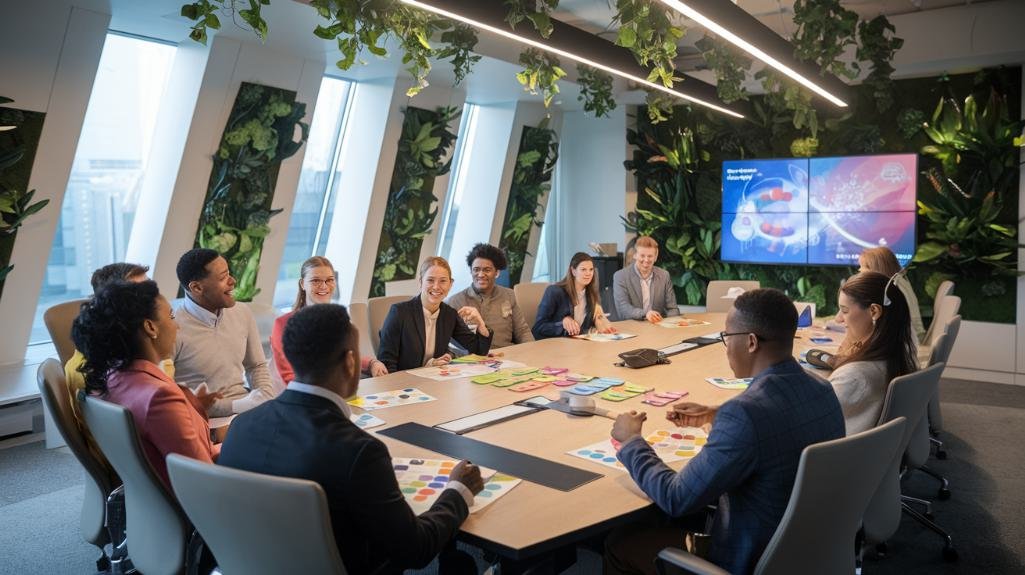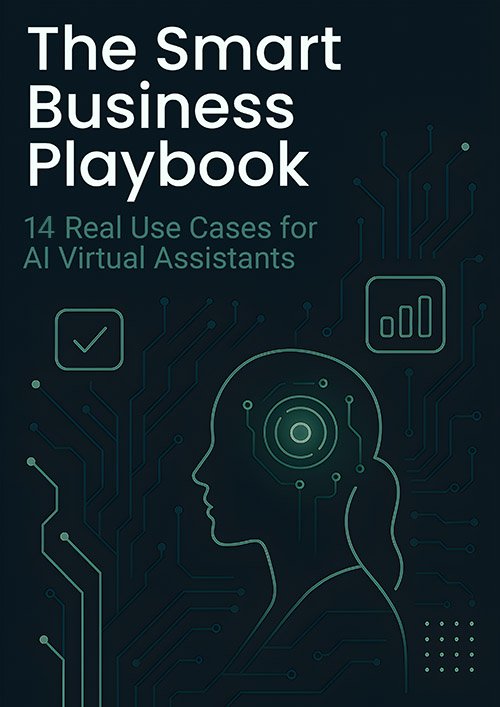To create an effective new hire orientation, start by giving a warm welcome with snacks and assigning a buddy. Use a structured agenda to set clear expectations and include interactive activities. Offer thorough training on software and insight into company culture. Facilitate early team connections and gather feedback for continuous improvement. Good orientation fosters belonging and support, ensuring new hires feel valued and ready to contribute. There are more insights available for an enhanced onboarding experience.
Key Takeaways
- Celebrate new hires’ arrival with welcoming activities like snacks and team lunches to foster a sense of belonging.
- Provide a structured orientation agenda, including company overviews and training, to set clear expectations.
- Ensure comprehensive software training and insights into company culture through engaging activities and resources.
- Analyze feedback from new hires to continuously improve the orientation program and enhance employee retention.
- Implement a buddy or mentorship system to support new hires and encourage collaboration from the start.
Establish a Warm Welcome

Creating a warm welcome for new hires isn’t just a nicety—it’s an essential part of integrating them into your company culture. Start by reducing their first-day anxiety with celebratory snacks like cake or donuts, setting a positive impression.
Assign a buddy or mentor to guide them, fostering immediate connections and helping them acclimate. A structured office tour is key; it introduces new employees to colleagues and familiarizes them with the workspace, enhancing their comfort and sense of belonging.
Organize a team lunch or an informal gathering; these events encourage bonding and make the new hire feel valued. By prioritizing these steps, you guarantee that new hires feel welcome and become active contributors to the team from day one.
Utilize a Structured Agenda
When planning a successful new hire orientation, utilizing a structured agenda is essential for setting the day’s tone and guaranteeing a seamless experience. This approach provides a clear framework, which helps reduce anxiety and set expectations.
By including time for introductions, company overviews, and training sessions, you guarantee all essential topics are covered without overwhelming your new hires.
- Share the agenda in advance to help new hires feel prepared and comfortable.
- Incorporate interactive activities to enhance engagement and foster a positive atmosphere.
- Track progress to guarantee all information is conveyed for faster acclimatization and increased productivity.
This method not only improves the orientation experience but also boosts engagement and productivity, guaranteeing your new hires feel welcomed and ready to contribute effectively.
Integrate Engaging Activities

When planning new hire orientation, focus on fostering team connections through engaging activities.
Incorporate interactive games like scavenger hunts or trivia to reinforce company values while keeping the atmosphere lively.
Additionally, schedule social gatherings such as informal lunches or coffee breaks to help new hires build relationships in a relaxed setting.
Foster Team Connections
Although it’s important to guarantee new hires are well-informed about their roles, fostering team connections through engaging activities can greatly enhance their onboarding experience.
By incorporating fun activities like team-building games and scavenger hunts, you create memorable experiences that help new hires connect with their colleagues.
Consider the following strategies to strengthen team dynamics:
- Plan informal lunch outings to encourage casual interactions and comfort within the work environment.
- Use icebreaker activities to facilitate introductions and promote camaraderie among team members.
- Implement a buddy system pairing new hires with experienced colleagues for guidance and relationship-building.
Organizing group discussions and team-building exercises further enhances collaboration and communication, ultimately solidifying team cohesion.
These efforts ensure your team feels connected and ready to contribute effectively from the start.
Include Interactive Games
Interactive games are a powerful tool that can transform a standard orientation into an engaging and memorable experience. By incorporating activities like trivia or scavenger hunts, you reinforce important company information while making the orientation enjoyable for new hires.
These team-building activities foster connections among new hires and existing employees, enhancing workplace camaraderie and promoting collaboration. Games such as Photo Hunt encourage newcomers to explore the office environment and learn about their colleagues in a fun, low-pressure setting.
Group participation helps break the ice and reduce anxiety, creating a more relaxed atmosphere. Engaging activities not only make the orientation dynamic but also contribute to higher retention rates by integrating new employees into the company culture effectively.
Plan Social Gatherings
Building on the energy and connections sparked by interactive games, planning social gatherings is a key step in crafting a holistic orientation experience.
These gatherings are instrumental in fostering team bonding, welcoming new hires, and strengthening employee connections.
Organize informal team lunches or coffee breaks during the first week to create a relaxed setting for relationship-building.
Implement engaging activities like scavenger hunts or themed trivia to reinforce company culture and make the adjustment smoother.
- Informal gatherings: Encourage relaxed interactions with team lunches or coffee breaks.
- Engaging activities: Use scavenger hunts or trivia for memorable team bonding.
- Structured events: Align with company culture and facilitate community building.
Provide Comprehensive Software Training
When onboarding new employees, ensuring they receive thorough software training is essential for their success and confidence in their roles.
Start with extensive software training that covers internal communication systems like email and chat platforms, so new hires are comfortable with these tools from day one.
Tailor role-specific software training to each position, focusing on the important systems they’ll use daily. Conduct walkthroughs that boost familiarity and efficiency.
Provide training resources and documentation for software applications, allowing them to revisit information anytime, supporting ongoing learning.
Incorporate hands-on training sessions, giving them a chance to practice in a controlled environment, which enhances knowledge retention.
This approach prepares them for real-world application, building a foundation for their future success.
Foster Early Team Connections
To foster early team connections, guarantee your new hires feel welcomed and supported from the moment they join. Inform colleagues about the new hire’s arrival to encourage spontaneous introductions, creating a welcome atmosphere.
Organize a team lunch or informal gathering within the first week to strengthen team bonds. Assign a buddy or mentor to guide them through work responsibilities and social dynamics.
Incorporate the following strategies:
- Include icebreakers or team-building games during orientations to facilitate fun interactions.
- Schedule one-on-one meetings between the new hire and team members for personal connections and knowledge sharing.
- Encourage a supportive environment that prioritizes relationship-building.
Offer Insight Into Company Culture
While integrating new hires into your organization, offering them insight into your company culture is essential for their successful acclimation. Incorporate engaging onboarding activities like scavenger hunts or team-building exercises to introduce new hires to your organizational values and foster employee engagement.
Share videos highlighting your company’s mission, vision, and daily operations to effectively convey your workplace culture. Providing branded merchandise can create a sense of belonging and pride from day one.
Include key leaders in orientation sessions to discuss your values and humanize the organization, strengthening their connection to leadership. An organizational overview that showcases your company’s history, achievements, and core values helps new hires align with your goals and instills a shared sense of purpose and belonging.
Gather Post-Orientation Feedback

After immersing new hires in your company culture, capturing their initial impressions through post-orientation feedback is pivotal for refining the onboarding experience.
Conduct effective surveys that explore:
- Their understanding of roles and responsibilities
- Feelings of welcome and comfort within the team
- Confidence in utilizing introduced systems and tools
Gather feedback promptly to swiftly address any concerns, thereby enhancing the orientation program.
By analyzing feedback trends, you can identify areas for improvement and minimize employee turnover. This approach fosters a genuine sense of connection and guarantees that new hires feel valued and supported.
Separating post-orientation surveys from broader onboarding assessments provides targeted insights, enabling you to pinpoint specific challenges in the initial phase and keep the orientation process relevant and effective.
Frequently Asked Questions
How to Make New Hire Orientation More Fun?
Make new hire orientation more fun by incorporating team building activities, icebreaker games, and interactive tours. Use creative presentations, fun quizzes, and engaging videos. Include welcome gifts and themed events. Consider group challenges or motivational speakers for inspiration.
What Should Be Included in an Orientation?
Think of orientation as the compass guiding you through company culture. You’ll explore a benefits overview, job expectations, workplace policies, team introductions, training schedules, performance standards, compliance training, safety protocols, and feedback mechanisms. Stay curious and engaged!
What Are the Most Frequent Complaints About New Employee Orientation?
You often experience overwhelming information and unclear expectations due to inconsistent scheduling and lack of engagement. Poor communication and insufficient resources lead to inadequate training, while minimal feedback and an unwelcoming environment create unrealistic timelines and dissatisfaction.
How Do I Make My New Hire Orientation Interactive?
To make your new hire orientation interactive, incorporate icebreaker activities, team building exercises, and interactive presentations. Use gamified learning, role playing scenarios, and Q&A panels. Provide hands-on training, buddy pairing, and virtual reality experiences, including feedback sessions.
Conclusion
Congratulations, you’ve survived the thrilling adventure of new hire orientation! You’ve mastered the fine art of maneuvering agendas and deciphering complex software—all while pretending to remember everyone’s names. You’ve bonded over awkward icebreakers and absorbed company culture like a sponge. Now, don’t forget to share your invaluable feedback, because who doesn’t love filling out one more survey? Embrace these best practices, and you’ll be well on your way to corporate stardom. Happy onboarding!


